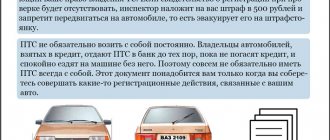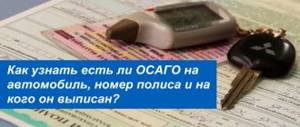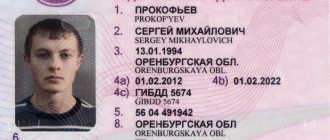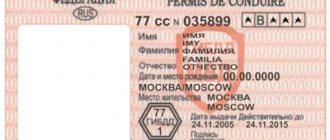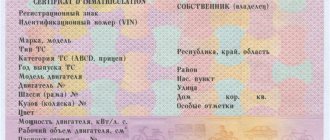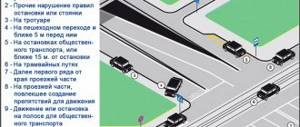What it looks like and where to look
PTS forms are produced in a printing house on blue A4 sheets and have several degrees of protection.
Each form is unique, that is, it has its own details, which include:
- a series of documents;
- Document Number;
- date of issue.
The PTS series consists of 2 numbers and 2 letters, and the number is 6 digits. The main details of the PTS are indicated at the top of the front side of the document.
How to fill out the series and PTS number? Details are assigned to each form during its production. Each organization that has the right to issue and issue motor vehicle passports makes a pre-order for a certain number of forms, which are delivered after they are produced.
What letters are not used in license plates?
- Route transport taxi signs . They are installed on modern public transport, taxis, that is, on public and commercial transport. These are dark yellow numbers with 2 letters and 3 black numbers. There is a region code, but no flag.
- Registration plates of the Ministry of Internal Affairs of Russia . Now they are installed on trucks, cars, trailers and motorcycles. The general format of these characters is one letter and four numbers.
- Number plates of vehicles belonging to modern Russian military formations of the legal executive authorities of Russia . Signs are installed on vehicles that belong to modern troops. Designations are applied to a plate that does not reflect light. The format is 4 numbers and 2 letters. The main information about the car is assigned to the code located on the right side of the license plate - it does not coincide with standard regional codes. Having studied it, experts understand which category of military units the transport belongs to.
- Registration numbers of cars that belong to diplomats and sales representatives of foreign companies . The main information on such numbers is the first three digits of the code and the letter, which is a prefix. Among the most basic combinations of such letters, we can note CD - the car of an ambassador or the head of a diplomatic official mission, CC - a car belonging to a consul or head of a consulate, D - a car belonging to a person holding a certain diplomatic status, T - a car of diplomatic consulate employees who do not have the corresponding status .
This is interesting: Fee for an extract from the Unified State Register with a tax signature via SBIS
Many people consider it quite complicated, but after studying the issuing system, the system becomes more or less understandable. In the process of registering new license plates, the following sequence of replacing numbers and letters is carried out:
Decoding the series and PTS number of the car
The series of a car's passport has a certain meaning. The numbers in the series indicate the number of the region in which the document was issued. For example, when receiving a passport in Moscow, series 77 is indicated.
You can check the PTS for originality by comparing the data in the document series and line 23 (name of the organization that issued the document) on the front side of the passport.
If the letters of the series match the regional organization, then the document is original. If the series is indicated in one region, and on line 23 - an organization in another region, then the document is a fake.
When examining a series of motor vehicle passports, you should also pay attention to the letters.
Until 2008, the first letter listed in the series was the letter "T". The exception is documents issued for foreign cars assembled in the Russian Federation.
After 2008, the letter "T" was replaced by the letter "U" due to the end of possible combinations of produced forms. If the letter designation of the form series begins with a different letter, then the document is fake.
Currently, counterfeit documents have been discovered that have a series starting with the letter “T”. These include:
The second letter of the series may be different. This information is not of fundamental importance.
The PTS number does not carry specific information - it is simply the serial number of the document assigned when the form was produced in the printing house.
How to correctly indicate in OSAGO
PTS is required to record the basic parameters of the car and its owners. The document must reflect the following information:
- VIN number (a unique number assigned by the vehicle manufacturer);
- make, model, color, year of manufacture, country and manufacturer of motor vehicles;
- type, volume and number of the engine, as well as numbers of other units;
- weight;
- Full name of the owner (name of the organization if the car belongs to a legal entity);
- residence (registration) address of the car owner;
- date of purchase, registration, deregistration;
- existing restrictions;
- re-equipment carried out and so on.
The document is required not only when buying (selling) a car, but also for concluding compulsory car insurance contracts.
Each insurance policy contains information about the series and number of the PTS, which is indicated in the column reserved for the description of the transport to which the policy applies.
If the OSAGO form is filled out correctly, the following must be indicated:
- type of document on the basis of which the insurance contract was concluded - PTS;
- series of the document provided;
- number of the provided document.
If an insurance contract is concluded for a used car that belongs to a certain person and is registered in the manner prescribed by law, then the policy form may indicate not the PTS details, but the corresponding details of the registration certificate.
What to do if you run out of entries in the PTS is explained in the article: what to do if you run out of space in the PTS.
How to pay the state fee for making changes to the PTS, read here.
Is it the same as STS?
A certificate of registration (CTC) of a motor vehicle is issued after the vehicle is registered with the territorial division of the State Traffic Inspectorate. The STS, just like a car passport, has its own details (series, number and date of issue).
The form of the certificate is approved by Order of the Ministry of Internal Affairs No. 1001, which regulates the rules for registering motor vehicles.
Details of the registration certificate are indicated on the front side:
- at the top of the document;
- at the bottom of the document.
The registration certificate completely duplicates the information specified in the car passport.
The document reflects the following data:
- VIN number;
- make, model, type and category of car;
- year of issue;
- engine, chassis, body numbers;
- power;
- weight;
- environmental class;
- owner registration details.
Additionally, each STS must indicate the details of the vehicle's passport.
PTS and STS details can:
- be different. This situation is more likely, since one document is issued by customs or the manufacturer, and the second document is issued by the traffic police, and based on the data specified specifically in the passport;
- may coincide. Coincidence of details is possible if PTS and STS are issued by the same organization, for example, when receiving a duplicate passport due to loss, theft, unsuitability, and so on.
The coincidence of the details of the two main documents of road transport is not accidental. This practice has become widespread recently to simplify the main activity of the road inspection, which is to supervise traffic safety.
With the same document details, you can quickly obtain information:
- about administrative fines unpaid by the car owner;
- about the vehicle being stolen or pawned;
- about passing periodic technical inspections and so on.
RESO-GARANTIA - reviews about the company
Previously, I was insured with another insurance company, but now I decided to switch to Reso-Garantiya. With difficulty (in 2 days), but I managed to issue a new electronic policy (EP) XXX0000850057. The process has turned into a labyrinth, from which you can exit with nerves of steel and enough time to consistently eliminate the mistakes made. Analyzing my “lost” time and angry reviews from those who failed to achieve results, I come to the conclusion that most of the negativity could have been avoided. To do this, Reso-Garantiya would have to change its approach to the process of development, testing, and implementation of software that ensures the collection, verification of data and registration of electronic signatures. So far, in my opinion, this software is not user-friendly, does not really help clients and does not protect them from errors. It is advisable to improve the software, and correct and supplement the instructions for registering the MTPL electronic signature. But this is a separate conversation... The adequacy of the power of servers and communication channels during the operation of the system also raises questions.
In order to make the process of obtaining a new electronic signature easier for other clients of the insurance company, below I will indicate the points that I recommend paying attention to. Everything written for those who own PASSENGER cars and who do not have serious data errors in the RSA database (to correct errors, you must submit documents to the Investigative Committee office). Before starting work with the electronic signature project, prepare the last issued OSAGO insurance policy (POP), the driver's license for all drivers whom you will enter in the electronic signature (see paragraph 16 below), a vehicle title, and, just in case, a SR vehicle and a diagnostic card. I recommend starting the registration of the electronic signature at least 25 days before the expiration of the previous one. Then you will have time for consultations with technical support and elimination of identified errors in the data. So: 1. Before entering your “Personal Account” (PA) (https://client.res.), find the word “Instructions” on the screen. Open it and copy it to your hard drive. If possible, print it (at least steps 6.1, 6.2, 7). Although this instruction is incomplete and contains errors, reading it carefully BEFORE working with the ES project will save you from a number of problems and save time. 2. After logging into your account, start filling out the details. In the “Compulsory Motor Liability Insurance Policy Parameters” section, pay attention to the logical correspondence of all dates. In one of my calculation projects, the program spontaneously changed the start date of “Use Period 1”, and this date became earlier than “Validity From”. I didn’t notice this right away and, naturally, this calculation project fell through. Periodically check the information previously entered into the project. 3. Nothing can be changed in the “Policyholder” section. Empty details in the subsection “Identity card” - “Date of issue”, “Issued” do not affect anything. 4. In the “Vehicle” section, select your option from the drop-down lists in the details “Brand”, “Model”, “by title”. Check everything with the PTS. If suddenly your option is not on the list, check how these details were indicated in the POP. As a last resort, describe the problem (and, better, with a scan of the PTS) and ask for help from technical support - how exactly to indicate your option in this section. 5. The program will determine the vehicle type automatically. (Although, she called the type of my car model “Off-road (jeep)”, while both the PTS and the SR TS clearly indicate the type - “Passenger”.) 6. Mark, if necessary, the use of a trailer. 7. Select “Year of Issue” from the list. For a passenger car, DO NOT CHANGE anything in the details “Number of passenger seats”, “Allowed max. mass, t", "Load capacity, t". 8. Enter “Power in hp” on the PTS. If a “miracle” happens and the PTS only indicates the engine power in kW: check the power for your model in hp. on the automaker's website; check as stated in the POP. Try entering the found value in hp into the project. As a last resort, seek advice from technical support as indicated in paragraph 4. 9. Select your version of the steering wheel location (although I don’t understand why this information is here for MTPL – maybe for repairs after an accident?). 10. When entering VIN (17 characters), use capital Latin letters and numbers. Do not confuse the Latin letter "O" with the number "0". If you indicated VIN, skip the “Body/Chassis Number” detail and do not enter anything there. If there is no VIN, please provide all details for the vehicle title. 11. “Reg. number" enter in capital Russian letters and numbers. Do not confuse the Russian letter "O" with the number "0". 12. Select “Purpose of using the vehicle” from the list. 13. Before entering data on PTS and CP vehicles, check which of these documents is indicated in section 2 of the POP. Enter the data from this document into the project. When entering the PTS series, use numbers and capital Latin letters (which is strange, since on the PTS itself in the Russian Federation the series is indicated with Russian letters!) letters. Do not enter the series in the field for the PTS number and vice versa. 14. If you indicated the details for the PTS, skip the details for the “Certificate of Registration” and do not enter anything there. 15. If the car is older than 3 years, d.b. passed MOT, with the issuance of a diagnostic card (DC). In the “Technical Inspection” section, enter the data of the current registration certificate (number and validity period). It is advisable to do so in advance on one of the sites that makes it possible to check the availability of a recreation center in the UAIS TO (for example, kbm-osago.ru›proverka-tehosmotra.html). Carefully rewrite from there the 21 digits of the recreation center number and the deadlines - then add them to the draft electronic signature. This path is necessary because, for example, on my paper copy of the recreation center there is a 15-digit “Registration Number”, which does not coincide at all with the 21-digit number of the same recreation center in the UAIS TO. And, of course, the 15-digit number did not pass the verification in the draft electronic signature. 16. In the “Available for management” section, select your “Without restrictions” attribute option. If you have a “Limited list”, enter your full name without abbreviations, series and license number (most likely, the program will “pass” only those drivers who were entered in the POP). I recommend using capital Russian letters to enter your full name and VU series (if there are letters in the series, do not confuse the letter “O” and the number “0”). The year of issue of the first license (December 31, XXXX), if it does not pass the test, you can try to find it by brute force. 17. The process of payment and receipt of electronic signature does not require any explanation. PS 18. If the program freezes and the “Server Internal Error...” block appears with text in English (which is strange - actually, we live in a Russian-speaking country!) with a proposal to reconnect, do not worry, immediately exit the LAN and start the procedure again entering data into a new project with “0”. 19. I recommend that work on registration of the electronic signature be carried out early in the morning or at the end of the evening. Perhaps the owners of the insurance company save on the power of servers and communication channels, and during the day, due to the large influx of clients, there is a general overload of the system, which causes its failures and freezes. In the morning and evening the load is less, and there is a greater chance of normal operation of the system.
This is interesting: For 3 children, payments in 2021 are 190 thousand in the Kemerovo region
How to find out the issue date
Unfortunately, using the basic details of a car passport (series and number) it is impossible to find out the date of issue of the document online.
Such information can be obtained only by personally contacting the State Traffic Inspectorate, providing the employee with a number of documents that confirm the ownership of the car and the identity of the applicant.
However, using the series and passport number of the car, for example, on the VINformer website, you can check the document for originality, which is especially important when buying a used car using a duplicate PTS.
To check, you must enter the following information in the form provided:
- the first three characters of the vehicle's VIN number;
- the organization that issued the vehicle passport;
- series, number and date of issue of the document;
- PTS issuing region.
During the check, you can find out not only the coincidence of the data specified in the document, but also the possibility of the car owner using a fake form.
You can obtain more complete information about the vehicle by checking it using the individual number (VIN). The check can be done on the previously mentioned website or the official portal of the State Traffic Inspectorate.
As a result of conducting independent research, you can find out:
- PTS details, including the date of issue of the document;
- main characteristics of road transport;
- history of registration actions, including the form of previous owners (individual or legal entity);
- the presence of restrictions imposed on the car or its owner;
- information about the theft or pledge of a car, and so on.
Thus, the vehicle passport details are unique for each document, but can be duplicated when receiving a vehicle registration certificate.
Using the PTS details, you can obtain additional information about the vehicle, as well as check the document for originality, which is important when purchasing used vehicles.
In what cases a duplicate PTS is issued is described in the article: duplicate PTS.
How many seats are in the PTS, see on the page.
Find out how much it costs to restore the title of a car if it is lost from this information.
This video is unavailable
— In the VU series, if there are letters there, for example 55 EN. They are entered in Russian letters. — In the STS series, if there are letters, for example 24 ST on Russian cars, they are entered in Russian letters, on foreign cars both Russian and English letters are acceptable! — VIN is entered in CAPITAL English letters — If you only have the year 2021 in the start date of your experience, then you need to write January 01 and your year is 01/01/2021
This is interesting: How long does it take to collect a passport for registration?
List of documents required to issue an MTPL policy - Online: 1). Policyholder's passport; 2). Driver's License (DR) for each driver who will be included in the policy *If the policy is made without limiting the number of drivers, then a DR is not needed. 3). Vehicle Registration Certificate (VTC) 4). Diagnostic Inspection Card *If your Inspection is valid, but it ends before the insurance (for example, it ends in 10 months), the company may skip it, but as soon as its period expires (12-10 = 2 months), then you will drive for 2 months without a Technical Inspection, and in the event of an accident within this period, the company will not pay you, since there was no guarantee that your Car was in good working order at the time of the accident!

